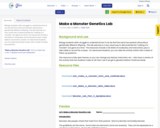
Unrestricted Use
CC BY
Biology students often struggle to understand how it can be that the same two parents will produce genetically different offspring. This lab exercise is a very visual way to demonstrate the "making of a monster" one gene at a time. The resources include a full sheet of vocabulary and instructions, plus a data table to record the crosses. For advanced students, you can take the activity further with a sheet of follow up questions.
- Subject:
- Living Systems and Processes
- Science
- Material Type:
- Activity/Lab
- Lesson
- Date Added:
- 01/02/2020